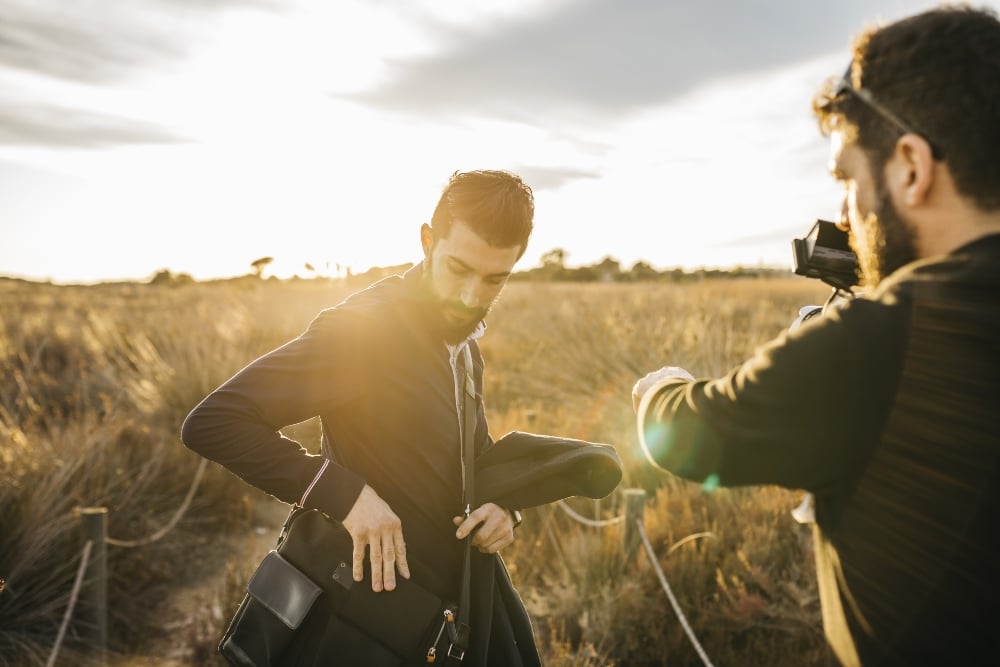Quality, Affordable Video Production That Comes To You, Anywhere
Over the last two years, the pandemic has shattered long-held structures within the world of work. The idea of a majority remote workforce shifted...
5 min read
 Ed Heil
:
August 22, 2022
Ed Heil
:
August 22, 2022
Editor's Note: This blog was updated for accuracy and relevance on August 27, 2024.
Here's a multiple-choice question for you. When a movie ends, and the credits roll, what do you do?
As a video producer, I'm ashamed to admit, but I dash for the door. Yes, I make mini-movies, so to speak, for a living, but I just don't care who the best boy was.
And really, does anyone (other than people in the industry) know the differences between the production assistant and the production coordinator? The prop maker and the prop master?
Recently, I had a conversation with someone who was looking to create a promotional video.
Prospective client: "I just don't like big productions. It doesn't need to be Hollywood."
Me: "What do you mean by big production?"
Prospective client: "There are all of these people standing around, and I don't even know what they do. It feels excessive for a two-minute video about our company."
And you know what? This person is right. You often don't need a huge video production for your video.
With that said, here are three different types of video production teams, all of which I've been a part of at one time or another:
Of course, these are general groupings of production crews that are intended to provide a sense for the scope of a video project. Of course, it's important to keep in mind that the more people involved, the higher the cost. Ultimately, it's up to you and your team to decide if the exposure of the project is worth the extra cost. Meaning, will your boss's, boss's boss want to see this? And secondly, what is the level of expectation that the audience will have for the production? Does your brand standard dictate the level of quality? Does your boss's, boss's boss expect a Hollywood production?
If you've ever seen a news team reporting in the community, this is a familiar set up, a videographer and a reporter or producer. What makes this basic is that there are only two moving parts — someone running the camera and another person interviewing subjects and coordinating the shoot. In many cases, this is all that is needed even when creating a highly effective, engaging, and professional corporate video. A talented basic crew can efficiently capture the right content, and often more content, because there are fewer people to manage, and they can be more nimble and flexible.
For example, and this happens on many of my shoots, I'll be capturing footage and notice something unexpected that enhances my client's story. With a two-person crew, it's pretty easy to break from the schedule or plan and go capture the additional footage. With more than two people, it's much more difficult to choreograph this change in plans. Often, with a bigger crew, this spontaneity usually comes with a cost, such as dropping other shots. With a smaller crew, you're much more likely to keep on schedule even when you're thrown a curve ball.
Here is an example of a video produced with a basic producer and a videographer crew.
Even though a basic crew will often do the trick for small and medium-sized business needs, sometimes you just need more help. With an expanded crew, you can expect additional team members like an audio technician, a grip, or a makeup artist to go along with the videographer and the producer.
An audio technician is brought on board when capturing the sound is crucial to the story. In a basic crew, the videographer is also in charge of the audio. For the expanded crew, the videographer solely focuses on the images, and the audio technician focuses on the sound. When location conditions are less than ideal for sound, I like to include an audio technician to make sure the audio is crystal clear.
Often, an expanded crew includes a grip, or a person who helps in any way they can — like setting up the gear, lights, etc. (Note, this is not an official definition. Some filmmakers might call me out on this, so please, see below for a list of unofficial titles and job duties.)
Here is a video that included a grip and an audio technician along with the producer and videographer. The grip was vital because we were lugging gear up and down stairs with a lot of different setups for interviews. Some of the rooms were a challenge for audio because the acoustics were really tricky, so we also brought in an audio technician.
This title might be a bit of an exaggeration, but anything over 5-7 crew members I consider a Hollywood-type crew. The time to bring in a Hollywood crew is when each and every shot has to be pristine. Everything must be perfect. I've found more and more that this isn't always necessary for corporate videos, but there are always exceptions.
I won't go into too much detail here and list the additional crew members, but this is where you'll start seeing people like craft services (they provide food), director of photography (the person who is in charge of the videographer), a gaffer (a person in charge of lighting) and so on.
So, when is it necessary to hire the "Hollywood crew"? When you're creating a national TV spot, or a music video, I'd say go for it! Your image is everything, so don't skimp on the production. Keep in mind, the more professionals involved with your production, the higher the costs.
Here is a video that would call for a "Hollywood crew":
If you're planning a video shoot, here is a short list of some crew titles and their responsibilities to help you understand what everyone does. But keep in mind, these are high-level definitions (so don't start throwing tomatoes, video production junkies).
Videographer - The videographer is the person running the camera.
Producer - The producer is in charge of the project. She/he often deals with the details and the money. For corporate videos, a producer often takes on the role of the director during the video shoot.
Director - The director is often the same person as the producer on smaller video shoots. The director's job is to make sure the shoot keeps moving forward and basically, tells everyone on the set what to do.
Audio Technician - The audio tech captures the sound. On small crews, audio techs sometimes double as a grip.
Gaffer - The gaffer is in charge of lighting.
Grip - The grip works with the gaffer to help adjust lights. On a smaller crew, the grip is like the utility player in baseball, helping out in a variety of ways. (Note, if there is more than one grip on set, the crew could have a key grip in charge of the grip team.)
Best Boy - The best boy is the key grip's number one assistant. They do things like make sure the lights have power or rent the lights needed for the project. (FYI - I've never had a best boy on a single video project.)
Makeup/Hair Stylist/Wardrobe - This one is self-explanatory.
Production Assistant - Production assistants work closely with the producer/director to do whatever is asked of them. Usually, it's things like printing scripts, picking up the gear, or bringing Diet Coke to the producer.
Craft Services - Craft services is everyone's favorite. They provide the food and beverages.
Talent - This is the person or people who will be on camera. Talent can be actors or company employees.
These are some of the more common video crew members. This can be a lot to take in. Things get more complicated (and more expensive) when you add a larger crew to the video shoot.

Over the last two years, the pandemic has shattered long-held structures within the world of work. The idea of a majority remote workforce shifted...

Finding talented videographers today isn't difficult. Hobbyists, college graduates, and long-toothed production experts are all over job posting...

Whether you are a hobbyist or a professional, everyone who produces a video needs one simple tool: a camera. You just can not shoot a video without a...